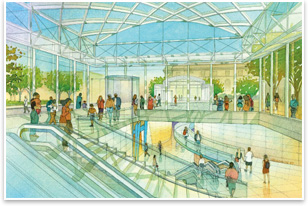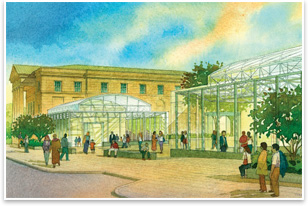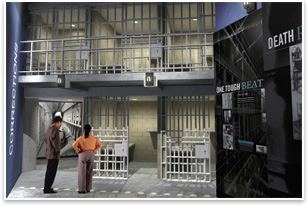National Law Enforcement Museum to Grace Nation’s Capital
Glass design highlights openness, democracy
by Russell Boniface
Associate Editor
 Summary: Plans for the National Law Enforcement Museum were unveiled February 28 at the National Press Club in Washington, D.C. The above- and below-grade facility, designed by Davis Buckley, FAIA, will be 95,000 square feet, the largest law enforcement museum in the world when completed in 2011. The museum will be located near the U.S. Capitol and directly across from the National Building Museum and National Law Enforcement Officers Memorial. Cutting-edge interactive exhibitions will allow visitors to learn about law enforcement, past and present. Summary: Plans for the National Law Enforcement Museum were unveiled February 28 at the National Press Club in Washington, D.C. The above- and below-grade facility, designed by Davis Buckley, FAIA, will be 95,000 square feet, the largest law enforcement museum in the world when completed in 2011. The museum will be located near the U.S. Capitol and directly across from the National Building Museum and National Law Enforcement Officers Memorial. Cutting-edge interactive exhibitions will allow visitors to learn about law enforcement, past and present.
 The National Law Enforcement Museum will honor America’s law enforcement heroes and serve as a repository of line-of-duty fatality records, law enforcement documents, and artifacts. Project Architect Davis A. Buckley, FAIA, who also designed the 1991 National Law Enforcement Officers Memorial and the 2000 National Japanese American Memorial, brings to the task a depth of understanding and a deft hand that promise a first-class museum. Buckley is the recipient of more than 24 design awards, including AIA awards and a Presidential Design Achievement Award. The National Law Enforcement Museum will honor America’s law enforcement heroes and serve as a repository of line-of-duty fatality records, law enforcement documents, and artifacts. Project Architect Davis A. Buckley, FAIA, who also designed the 1991 National Law Enforcement Officers Memorial and the 2000 National Japanese American Memorial, brings to the task a depth of understanding and a deft hand that promise a first-class museum. Buckley is the recipient of more than 24 design awards, including AIA awards and a Presidential Design Achievement Award.
Glass pavilions symbolize openness of law enforcement
The museum will be located in Judiciary Square, which has a long-standing connection with law enforcement buildings, from the memorial to surrounding courthouses. The above-ground portion of the museum will consist of two glass entry pavilions fronting a grand public plaza. Below grade will be a mezzanine, a Grand Hall exhibit level, and an administrative level.
 “The museum is a companion piece to the memorial, but it’s different,” explains Buckley. “The transparency of the glass pavilions symbolizes that law enforcement is open, accessible, and representative of our democratic society. The pavilion roofs are glass to enhance openness as you enter. You have views to the outside and to the north to the memorial as you make your way down to the Grand Hall. You’re surrounded by a cascade of multiple beams of light from the ceiling above. The natural light embraces and surrounds you—a visual symphony of light creating intricate, ever-changing patterns across the museum surface. You feel you’re in a special place—a special precinct. At the mezzanine level, one can cross a glass bridge that floats like a cloud, where you can look down to the Grand Hall and exhibits below. “The museum is a companion piece to the memorial, but it’s different,” explains Buckley. “The transparency of the glass pavilions symbolizes that law enforcement is open, accessible, and representative of our democratic society. The pavilion roofs are glass to enhance openness as you enter. You have views to the outside and to the north to the memorial as you make your way down to the Grand Hall. You’re surrounded by a cascade of multiple beams of light from the ceiling above. The natural light embraces and surrounds you—a visual symphony of light creating intricate, ever-changing patterns across the museum surface. You feel you’re in a special place—a special precinct. At the mezzanine level, one can cross a glass bridge that floats like a cloud, where you can look down to the Grand Hall and exhibits below.
“It is a building of its time in terms of architecture within a historical setting. The pavilions are a wonderful architectural response to the classical limestone-clad public buildings around the square.” Buckley is working toward a LEED® Silver rating for the museum.
 Experiencing the museum Experiencing the museum
The museum will feature eye-catching audio-visual exhibitions designed by Boston-based Christopher Chadbourne to include:
- Hall of Remembrance, dedicated to America’s fallen law enforcement heroes
- History of Law Enforcement, examining law enforcement throughout U.S. history
- Being an Officer, where visitors “walk in an officer’s
shoes,” perform driving simulations, and participate in forensics
- Take the Case, allowing visitors to work with a virtual detective, interrogate suspects, and collect evidence
- Corrections, where visitors learn what officers face inside corrections facilities
- SWAT, highlighting surveillance, K-9s, undercover, and bomb squads
- Public Enemies Theater, giving visitors a chance to relive the days of the Lindbergh kidnapping and Bonnie and Clyde
- Reel to Real, showcasing law enforcement in media/pop culture.
 The museum will serve as a forum for conferences and provide educational programs. The repository will include a database on the nearly 18,000 law enforcement officers in the U.S. who have been killed in the line of duty, dating back to the first death in 1792. The museum will serve as a forum for conferences and provide educational programs. The repository will include a database on the nearly 18,000 law enforcement officers in the U.S. who have been killed in the line of duty, dating back to the first death in 1792.
The recent unveiling also launched the $80 million fundraising campaign, “A Matter of Honor: The Campaign to Support The National Law Enforcement Museum.” Presidents Bill Clinton and George H.W. Bush are honorary co-chairs of the campaign. |






